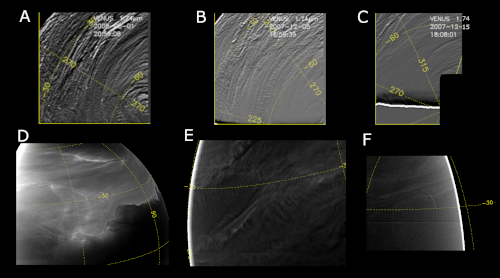Final Results on Atmospheric Wave Characterisation on the Nightside Lower Clouds of Venus
- 1Institute of Astrophysics and Space Sciences, Lisbon, Portugal (jsilva@oal.ul.pt)
- 2Universidad de Sevilla, Spain
- 3Laboratoire de Météorologie Dynamique (LMD/IPSL), Sorbonne Université, Centre National de la Recherche Scientifique, École Polytechnique Normale Supérieure, Paris, France
- 4Department of Physics (Atmospheric, Oceanic and Planetary Physics), University of Oxford, Parks Rd, Oxford, OX1 3PU, UK
An atmospheric internal gravity wave is a oscillatory disturbance on an atmospheric layer in which buoyancy acts as the restoring force. As such, they can only exist in a continuously stably stratified atmosphere, that is, a fluid in which the static stability is positive and horizontal variations in pressure are negligible when compared to the vertical variations (in altitude) [Gilli et al. 2020; Peralta et al. 2008]. These waves are of particular interest because they represent an effective means of energy and momentum transport across various layers of a planetary atmosphere, as these waves can form on one atmospheric region and travel through the atmosphere, sometimes over great distances, and dump their contained energy upon wave dissipation or breaking [Alexander et al. 2010]. Given these properties, study of atmospheric waves on Venus becomes important as another tool to answer some of the fundamental question surrounding its atmosphere dynamics, mainly the origin and support mechanism of the remarkable superrotation of the atmosphere.
We present here the final results on a study conducted on the nightside lower cloud of Venus to detect and characterise mesoscale waves. This analysis was conducted with infrared imaging data from both the Visible and Infrared Thermal Imaging Spectrometer (VIRTIS) onboard Venus Express (Vex) [Svedhem et al. 2007] and the 2-micron camera (IR2) onboard Akatsuki [Nakamura et al. 2011, Satoh et al. 2016] space missions. We covered the entire VIRTIS-M-IR archive selecting the 1.74- and 2.25-micron wavelengths as well as all available images from the IR2 camera at 2.26 microns to ensure a most comprehensive survey and through image navigation and processing we were able to characterise approximately 300 wave packets across more than 5500 images over a broad range of latitudes on Venus. From these waves we retrieved basic morphological properties such as horizontal wavelength, number of crests and the full extent of the wave. Additionally, we were able to track the evolution of waves as they moved on the atmosphere, enabling some dynamical characterisation. The panel below shows examples of atmospheric waves observed in this study. Figures A-C show VIRTIS-M-IR images while figures D-F show IR2 data. All images have been subject to contrast enhancement techniques to improve observability of waves.

Our goal was to provide a survey on atmospheric waves in the lower cloud as complete as possible, using two different instruments which cover in detail different sections of the globe of Venus over a long-time span, expanding on other studies performed by Peralta et al. (2008), (2019). With the larger data base, we discuss the nature of these waves, possible forcing mechanisms, and their relationship with the background atmosphere. Several questions remain however, such as how much energy do these waves transport in the cloud layer and how much do they contribute to Venus’ superrotation and if there is a dominant source of excitation for these waves. Full details of these results can be found in Silva et al. (2021) and we hope that these updated results can prove useful to recent and future models of Venus atmosphere as well as atmosphere of other slow rotators in the Solar System.
References
- Alexander M.J. et al, Quarterly Journal of the Royal Meteorological Society, vol. 136, pp. 1103-1124, 2010;
- Gilli G. et al, Journal of Geophys. Research – Planets, ID. e05873, 2020;
- Nakamura M. et al, Earth, Planets and Space, vol. 63, pp. 443-457, 2011;
- Peralta J. et al, Journal of Geophysical Research, vol. 113, ID. E00B18, 2008;
- Peralta J. et al, Icarus, vol. 333, pp. 177-182, 2019;
- Satoh T. et al, Earth, Planets and Space, vol. 68, ID. 74, 2016;
- Silva J. et al, A&A, vol. 649, ID. A34, 2021;
- Svedhem H. et al, Planetary and Space Science, vol. 55, pp. 1636-1652, 2007;
How to cite: Silva, J., Machado, P., Peralta, J., Brasil, F., Lebonnois, S., and Lefèvre, M.: Final Results on Atmospheric Wave Characterisation on the Nightside Lower Clouds of Venus, Europlanet Science Congress 2021, online, 13–24 Sep 2021, EPSC2021-40, https://doi.org/10.5194/epsc2021-40, 2021.

